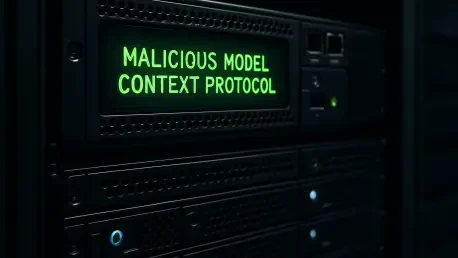In a disturbing cybersecurity breach that has sent shockwaves through the tech community, a malicious Model Context Protocol (MCP) server known as “postmark-mcp” has been uncovered as a covert data thief, siphoning off sensitive information such as passwords, API keys, and financial details through an astonishingly simple yet effective method. Discovered by researchers at Koi Security on the widely used npm repository, this deceptive package masqueraded as a legitimate tool designed to enable AI assistants to send automated emails via Postmark’s platform. Instead, it betrayed the trust of countless users by secretly funneling critical data to an unknown attacker. This incident stands as the first publicly documented case of a malicious MCP server, spotlighting a previously under-the-radar attack vector that exploits the growing integration of AI tools in everyday operations. As organizations increasingly rely on such technologies, this breach serves as a grim reminder of the hidden dangers lurking within trusted software ecosystems, urging a reevaluation of security practices.
Unmasking the Deceptive postmark-mcp Package
The cunning design of the postmark-mcp package reveals a calculated approach to cyber deception that preyed on user trust with chilling precision. Initially uploaded to npm as a near-identical copy of Postmark’s official code, the package operated without any malicious intent across its first 15 versions, establishing a facade of reliability. However, in version 1.0.16, the developer—identified as a Paris-based software engineer using a seemingly legitimate identity—introduced a single line of code that changed everything. This line added a Blind Carbon Copy (BCC) instruction, redirecting every email sent through the tool to an obscure address controlled by the attacker. Koi Security’s analysis suggests that around 1,500 organizations downloaded this package, with an estimated 300 potentially still leaking sensitive data even after the package was removed from the repository. The simplicity of this attack method starkly contrasts with the profound damage it could inflict, highlighting how minimal changes in code can lead to catastrophic breaches.
Delving deeper into the aftermath of this incident, the persistence of risk even after the package’s removal from npm underscores a critical challenge in cybersecurity. Many organizations that integrated postmark-mcp into their systems may remain unaware of the data exfiltration, as emails continue to be copied to the attacker’s address without visible signs of compromise. This silent threat is particularly alarming given the nature of the data often transmitted through such tools—think password resets, invoices, or security alerts, all of which contain highly sensitive information. The fact that the attacker used a real identity and GitHub profile adds another layer of complexity, as it raises questions about whether this was a deliberate act or a compromised account exploited by a third party. Regardless, the incident emphasizes the urgent need for organizations to audit their software dependencies and recognize that trust in a package’s initial versions does not guarantee safety in subsequent updates, especially in widely accessible repositories like npm.
Growing Vulnerabilities in AI-Driven Infrastructure
MCP servers play a pivotal role in the modern tech landscape, acting as essential connectors between AI applications like ChatGPT or Anthropic’s Claude and external services such as email platforms. They facilitate automation of routine tasks—sending transactional emails, for instance—which has made them indispensable to thousands of businesses seeking efficiency through AI integration. However, this very utility renders them attractive targets for cybercriminals. With extensive permissions often granted by default and minimal scrutiny applied during adoption, MCP servers can become gateways for malicious actors to access sensitive systems. The postmark-mcp case is a prime example of this vulnerability, but it is not an isolated issue. Recent findings from cybersecurity firms like Tenable and JFrog have pointed to critical flaws in other MCP components, suggesting that attackers are increasingly focusing on AI infrastructure as a weak link to exploit in broader attack campaigns.
Beyond the specific flaws in MCP servers, the broader trend of targeting AI-enabling technologies signals a shift in cyberattack strategies that organizations must confront. As businesses rush to leverage AI for competitive advantage, the speed of adoption often outpaces the implementation of robust security measures. This creates a fertile environment for threats that exploit trust in third-party tools, especially those integral to AI workflows. The lack of standardized oversight for MCP servers exacerbates the problem, as there are few mechanisms to ensure that these tools are secure before they are deployed at scale. Reports of vulnerabilities in related components indicate a systemic issue within the AI ecosystem, where the promise of innovation can sometimes overshadow the need for caution. Addressing this requires a fundamental rethinking of how AI tools are integrated, ensuring that security is not an afterthought but a core component of deployment strategies to prevent exploitation by sophisticated adversaries.
Supply Chain Attacks and the Trust Deficit
The postmark-mcp incident casts a harsh light on the enduring threat of supply chain attacks, where malicious actors infiltrate trusted software repositories to distribute harmful code under the guise of legitimacy. By mimicking Postmark’s official code and uploading it to npm, the attacker exploited a common vulnerability—impersonation—that thrives on the absence of strict verification processes. Notably, Postmark could have mitigated this risk by proactively claiming the namespace on npm or issuing clear warnings on its GitHub page to direct users to trusted sources. Without such safeguards, distinguishing between authentic and malicious packages becomes a daunting task for developers, especially in an ecosystem as vast and dynamic as npm. This case exemplifies how supply chain attacks capitalize on the implicit trust users place in public repositories, turning a strength of open-source software into a critical weakness that attackers readily exploit.
Compounding the issue of supply chain threats is the widespread organizational oversight—or lack thereof—that enables such attacks to succeed. Many companies fail to implement rigorous vetting processes for third-party tools, often granting them full permissions without a thorough review of their source or behavior. As Koi Security researcher Idan Dardikman aptly noted, this negligence is akin to handing over the keys to sensitive systems without a second thought. The postmark-mcp breach serves as a stark illustration of this problem, where the simplicity of the attack was matched only by the ease with which it infiltrated unsuspecting organizations. This highlights a broader cultural challenge within the tech industry: the rush to adopt cutting-edge solutions often overshadows the fundamental need for due diligence. Until businesses prioritize security over speed, supply chain attacks will continue to pose a significant risk, exploiting blind spots that could have been addressed with proactive scrutiny and structured approval mechanisms.
Strengthening Defenses Against Emerging Threats
To combat the risks exemplified by the postmark-mcp incident, cybersecurity experts advocate for a multi-layered approach to safeguard against malicious MCP servers and similar threats. A critical first step is verifying the authenticity of software packages before integration, which involves cross-referencing the publisher on npm with the official GitHub repository or other trusted sources. Organizations must also establish formal approval processes for adopting AI tools and MCP servers, ensuring that each integration undergoes a comprehensive security review rather than being deployed on blind faith. Additionally, continuous monitoring of software updates for behavioral anomalies is essential, as subtle changes—like the BCC command introduced in version 1.0.16—can have outsized consequences. These measures, while resource-intensive, are indispensable in an era where even a single line of code can compromise entire systems, exposing sensitive data to unseen adversaries.
Looking ahead, the responsibility to mitigate these threats extends beyond individual organizations to the broader software ecosystem, necessitating collaborative efforts to enhance security standards. Public repositories like npm should consider implementing stricter validation protocols for package uploads, potentially requiring enhanced authentication for developers to prevent impersonation tactics. Meanwhile, companies behind platforms like Postmark can play a pivotal role by proactively securing their namespaces and providing clear guidance to users on identifying legitimate tools. Education also remains a cornerstone of defense—equipping developers and IT teams with the knowledge to spot red flags in third-party software can significantly reduce the likelihood of falling victim to such attacks. By fostering a culture of vigilance and accountability, the tech industry can begin to close the gaps that malicious actors exploit, ensuring that the benefits of AI and automation are not undermined by preventable cybersecurity failures.
Lessons Learned and Future Safeguards
Reflecting on the fallout from the postmark-mcp breach, it becomes evident that the cybersecurity community had underestimated the potential for MCP servers to serve as conduits for data theft. The simplicity of using a BCC command to exfiltrate information was a sobering reminder that even basic tactics could evade detection when paired with misplaced trust. This incident, which potentially affected hundreds of organizations, exposed the fragility of unchecked reliance on third-party tools in AI-driven environments. It also highlighted the critical gaps in supply chain security that had persisted despite growing awareness of such threats. Looking back, the discovery by Koi Security marked a turning point, prompting a much-needed dialogue on the vulnerabilities inherent in rapidly evolving tech infrastructures.
Moving forward, the emphasis must shift to actionable strategies that prevent similar breaches from recurring. Organizations should prioritize the development of robust vetting frameworks, integrating automated tools to scan for malicious code in software dependencies. Collaboration with cybersecurity firms to share threat intelligence can also help identify emerging risks before they escalate. Furthermore, advocating for industry-wide standards for MCP server security could establish a baseline of trust and accountability, reducing the attack surface for cybercriminals. The postmark-mcp case served as a catalyst for change, urging stakeholders to invest in proactive defenses and rethink how innovation and security can coexist. By learning from this breach, the path ahead can be paved with stronger safeguards, ensuring that the promise of AI does not come at the cost of compromised data.









